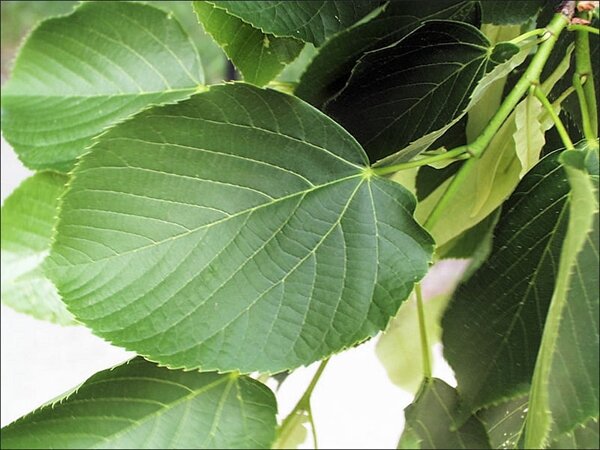Unconventional Value of Basswood Trees
by Jeanne Siviski
American Basswood Leaves
They say that money doesn’t grow on trees. But, you might not anticipate some things that grow on, or are products of, basswood. For instance, trees are not the normal source for salad greens. In springtime, when the leaves of the basswood are small and glossy, they are sweet and delicious. While foraging for wild edibles, it’s worthwhile to reach up and pluck some for a spring salad mix.
The large, heart-shaped leaves make basswood (Tilia americana) relatively easy to identify. They can be found growing at the toe of slopes or river plains, often amongst a mix of maples, white ash, birch, red oak or beech. They favor rich, moist soil. The fact that they can grow to be 80 feet tall means that you may need really long arms to reach leaves of the lowest limbs. In May, I clamber my way into the tree stand in a large basswood on our property just to pick the leaves while still tender and palatable.
To create more abundant, easily-reached edible leaves, some people have coppiced basswoods. An ancient woodland management practice, coppicing is the repetitive harvesting of growth produced from shoots of trees felled near ground level. However, that new growth would be right in the path of any deer that might come browsing by. Pollarding, similar to coppicing, involves cutting a tree back to a height above browsing level. Harvesting leaves from a pollarded tree would require a small step ladder.
Trees are not the conventional resource for domestic animal feed. But, production of “pollard hay” was one of the original purposes of pollarding in Medieval Europe. Trees with epicormic branching, like basswood, or its European cousin, the linden (Tilia x europaea), are suitable pollarding candidates. Tree species in the Tilia genus would have also been pollarded for wood products; it carves easily, like butter, and can be used for rope-making. In some locations, pollarding is still practiced to produce fodder. Pollarded lindens in Europe today, though, are mainly urban roadside plantings.
Edible uses of basswood are not limited to just the leaves. Before the leaves have opened, when the sap is running, a syrup can be made. Basswood buds make a trailside nibble or emergency wilderness food source. During May or June, the cambium layer can be scraped off and eaten.* Basswood flowers are edible and can be used to make tea. ** To say that chocolate grows on basswood would be a stretch. However, by grinding the young fruits and flowers of the basswood together, a fair chocolate substitute can be made. In pre-modern Latin America, cacao beans were actually used as currency. So, perhaps money, or a fair imitation of it, does grow on certain trees.
*Eating the cambium layer of basswood would damage the tree and is best reserved for trees being harvested.
**Though rare, some people do have an allergic reaction to the flowers. This article is for informational purposes only. Consulting a healthcare professional is advisable.

